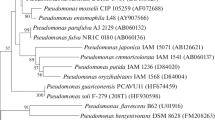Abstract
Four different bacterial isolates obtained from a stable bacterial consortium were capable of utilizing pentachlorophenol (PCP) as sole carbon and energy source. The consortium was developed by continuous enrichment in the chemostat. The degradation of PCP by bacterial strain was preceded through an oxidative route as indicated by accumulation of tetrachloro-ρ-hydroquinone and dichlorohydroquinone as determined by high performance liquid chromatography (HPLC). Among the four isolates, Pseudomonas fluorescens exhibited maximum degradation capability and enzyme production. PCP-monooxygenase enzyme was extracted from culture extract and fractionated by DEAE-cellulose ion exchange chromatography. The molecular weight of the enzyme, purified from Pseudomonas fluorescens, determined by sodium dodecyl sulphate polyacrylamide gel electrophoresis (SDS-PAGE) and gel filtration chromatography was found to be 24,000 Da.
Similar content being viewed by others
Author information
Authors and Affiliations
Additional information
Received: 22 July 2002 / Accepted: 23 September 2002
Rights and permissions
About this article
Cite this article
Shah, S., Thakur, I. Enzymatic Dehalogenation of Pentachlorophenol by Pseudomonas fluorescens of the Microbial Community from Tannery Effluent. Curr Microbiol 47, 0065–0070 (2003). https://doi.org/10.1007/s00284-002-3927-y
Issue Date:
DOI: https://doi.org/10.1007/s00284-002-3927-y




